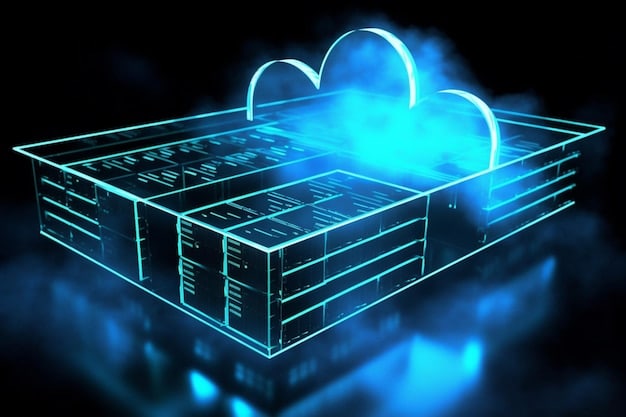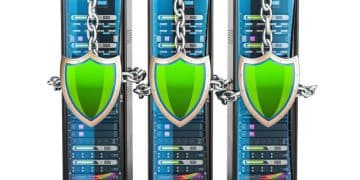Cloud Security Best Practices: Ensuring Data Safety in 2025

Cloud security best practices in 2025 will emphasize proactive threat detection, robust data encryption, and adaptive identity management to safeguard sensitive information in an increasingly complex digital landscape.
Cloud security best practices: ensuring your data is safe in the cloud in 2025 is a constantly evolving challenge. As cloud adoption continues to surge, so too do the sophistication and frequency of cyber threats targeting cloud environments. Staying ahead requires a proactive, multi-layered approach.
Understanding the Evolving Cloud Security Landscape
The cloud landscape is constantly changing, demanding a continuous evolution in security strategies. Understanding the challenges and trends shaping cloud security is crucial for building a robust defense.
Here are some key aspects of the evolving cloud security landscape:
The Growing Complexity of Cloud Environments
Organizations are increasingly adopting multi-cloud and hybrid cloud strategies, adding complexity to their security postures. Managing security across diverse environments requires a unified approach.
Securing these complex environments requires:
- Centralized visibility and control
- Automated security policies
- Standardized security configurations
The Rise of Advanced Threats
Cybercriminals are becoming more sophisticated, utilizing AI and machine learning to launch targeted attacks. Traditional security measures may not be sufficient to counter these advanced threats.
To combat advanced threats, consider:
- Implementing AI-powered threat detection systems
- Conducting regular vulnerability assessments
- Training employees on the latest phishing techniques

In conclusion, adapting to the evolving landscape requires a proactive and comprehensive approach to cloud security, addressing both the complexities of modern cloud environments and the sophistication of emerging threats.
Implementing Robust Identity and Access Management (IAM)
Identity and Access Management (IAM) is the cornerstone of cloud security. Strong IAM practices ensure that only authorized users have access to sensitive data and resources.
Effective IAM involves:
Multi-Factor Authentication (MFA)
Implementing MFA adds an extra layer of security, requiring users to provide multiple forms of identification. This makes it more difficult for attackers to gain unauthorized access.
MFA best practices include:
- Enabling MFA for all user accounts, especially those with privileged access
- Using a variety of authentication methods, such as biometrics and hardware tokens
- Regularly reviewing and updating MFA configurations
Least Privilege Access
Granting users only the minimum level of access required to perform their job functions limits the potential damage from compromised accounts. Least privilege access reduces the attack surface and minimizes the impact of security breaches.
Achieving least privilege access requires:
- Defining clear roles and responsibilities
- Regularly reviewing user permissions
- Automating access provisioning and deprovisioning processes
IAM is crucial for maintaining a secure cloud environment. By implementing strong authentication mechanisms and adhering to the principle of least privilege, organizations can significantly reduce the risk of unauthorized access and data breaches.
Data Encryption: Protecting Data at Rest and in Transit
Data encryption is a fundamental security measure that protects sensitive data from unauthorized access. Encrypting data both at rest and in transit ensures confidentiality and integrity.
Here’s why data encryption is essential:
Encryption at Rest
Encrypting data at rest protects it from physical theft or unauthorized access to storage devices. Data should be encrypted before being stored in the cloud, and encryption keys should be managed securely.
Strategies for encryption at rest include:
- Using cloud provider’s encryption services
- Implementing third-party encryption solutions
- Managing encryption keys using hardware security modules (HSMs)
Encryption in Transit
Encrypting data in transit protects it from eavesdropping during transmission. Secure protocols such as TLS/SSL should be used to encrypt data transmitted between clients and servers.
Best practices for encryption in transit include:
- Enforcing HTTPS for all web traffic
- Using secure VPN connections for remote access
- Implementing end-to-end encryption for sensitive communications
By implementing data encryption at rest and in transit, organizations can effectively protect sensitive information from unauthorized access, ensuring compliance with data privacy regulations and maintaining customer trust.

Implementing Proactive Threat Detection and Response
Proactive threat detection and response are critical for minimizing the impact of security incidents. Implementing robust monitoring and detection mechanisms enables organizations to identify and respond to threats in real-time.
Key components of proactive threat detection and response include:
Security Information and Event Management (SIEM)
SIEM systems collect and analyze security logs from various sources, providing a centralized view of security events. SIEM enables organizations to detect suspicious activity and respond to incidents quickly.
Effective SIEM implementation involves:
- Configuring SIEM to collect logs from all relevant sources
- Creating custom rules and alerts to detect specific threats
- Integrating SIEM with other security tools for automated response
Intrusion Detection and Prevention Systems (IDPS)
IDPS monitor network traffic for malicious activity and automatically block or mitigate threats. IDPS can detect a wide range of attacks, including malware, network intrusions, and denial-of-service attacks.
IDPS capabilities are enhanced by:
- Configuring IDPS to monitor all network traffic
- Keeping IDPS signatures up-to-date
- Integrating IDPS with other security tools for coordinated response
Proactive threat detection and response are essential for maintaining a secure cloud environment. By implementing SIEM and IDPS, organizations can detect and respond to threats quickly, minimizing the impact of security incidents.
Automating Security Policies and Compliance
Automation is crucial for maintaining consistent security policies and ensuring compliance with regulatory requirements. Automating security tasks reduces manual effort and minimizes the risk of human error.
Here’s how automation can enhance cloud security:
Infrastructure as Code (IaC)
IaC allows organizations to define and manage infrastructure using code, enabling consistent and repeatable deployments. IaC can be used to automate the deployment of security controls and ensure that all resources are configured securely.
Benefits of IaC for security include:
- Ensuring consistent security configurations across all environments
- Automating the deployment of security patches and updates
- Reducing the risk of misconfiguration
Compliance as Code
Compliance as Code allows organizations to define and enforce compliance policies using code, ensuring that all resources meet regulatory requirements. Compliance as Code can be used to automate compliance checks and generate reports.
Implementation of Compliance as Code includes:
- Defining compliance policies in code
- Automating compliance checks
- Generating compliance reports
Automation is essential for maintaining consistent security policies and ensuring compliance with regulatory requirements. By implementing IaC and Compliance as Code, organizations can reduce manual effort and minimize the risk of human error.
Fostering a Culture of Security Awareness
Security awareness training is crucial for educating employees about the latest threats and best practices. A strong security culture empowers employees to identify and report suspicious activity.
Key elements of a security awareness program include:
Regular Training Sessions
Conducting regular training sessions keeps employees up-to-date on the latest threats and best practices. Training should cover topics such as phishing, malware, and social engineering.
Effective training sessions are enhanced by:
- Using engaging and interactive content
- Tailoring training to specific roles and responsibilities
- Providing ongoing reinforcement and reminders
Phishing Simulations
Conducting phishing simulations tests employees’ ability to identify and report phishing emails. Simulations can help identify areas where employees need additional training.
A successful phishing simulation requires:
- Creating realistic phishing emails
- Tracking employee responses
- Providing feedback and training to employees who fall for the simulation
Fostering a culture of security awareness is essential for maintaining a secure cloud environment. By educating employees about the latest threats and best practices, organizations can empower them to identify and report suspicious activity.
| Key Point | Brief Description |
|---|---|
| 🛡️ Identity Management | Implement MFA and least privilege access to secure user accounts. |
| 🔒 Data Encryption | Encrypt data both at rest and in transit to protect sensitive information. |
| 🚨 Threat Detection | Use SIEM and IDPS to proactively detect and respond to security threats. |
| 🤖 Automation | Automate security policies and compliance using IaC and Compliance as Code. |
Frequently Asked Questions (FAQ)
▼
MFA requires users to provide multiple forms of identification, adding an extra layer of security. This makes it significantly harder for attackers to gain unauthorized access, even if they have a password.
▼
Data encryption scrambles data, making it unreadable to unauthorized users. Encrypting data at rest and in transit ensures that sensitive information remains confidential and protected from breaches.
▼
SIEM systems collect and analyze security logs from various sources, providing a centralized view of security events. This enables organizations to detect suspicious activity and respond to incidents quickly and effectively.
▼
Security awareness training educates employees about the latest threats and best practices, empowering them to identify and report suspicious activity. This reduces the risk of human error and strengthens overall security posture.
▼
IaC allows managing and provisioning infrastructure using code instead of manual processes. This ensures consistent and repeatable deployments, reducing misconfiguration risks and improving overall security and scalability.
Conclusion
As we look towards 2025, prioritizing cloud security best practices: ensuring your data is safe in the cloud in 2025 is non-negotiable. By focusing on proactive measures, such as robust IAM, data encryption, and automated security policies, organizations can navigate the evolving threat landscape and safeguard their valuable data in the cloud.





